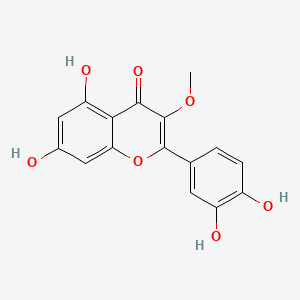| MeSH term | MeSH ID | Detail |
|---|---|---|
| Cell Transformation, Neoplastic | D002471 | 126 associated lipids |
3-O-Methylquercetin
3-O-Methylquercetin is a lipid of Polyketides (PK) class. 3-o-methylquercetin is associated with abnormalities such as Colitis, Hemorrhagic diarrhea and Diabetes. The involved functions are known as Inflammation, Trans-Activation (Genetics), Signal Transduction, Binding, Competitive and Antiinflammatory Effect. 3-o-methylquercetin often locates in Mucous Membrane. The associated genes with 3-O-Methylquercetin are IL2 gene, Human gene and ABCB1 gene. The related experimental models are Streptozotocin Diabetes.
Cross Reference
Introduction
To understand associated biological information of 3-O-Methylquercetin, we collected biological information of abnormalities, associated pathways, cellular/molecular locations, biological functions, related genes/proteins, lipids and common seen animal/experimental models with organized paragraphs from literatures.
What diseases are associated with 3-O-Methylquercetin?
3-O-Methylquercetin is suspected in Colitis, Hemorrhagic diarrhea, Diabetes and other diseases in descending order of the highest number of associated sentences.
Related references are mostly published in these journals:
| Disease | Cross reference | Weighted score | Related literature |
|---|
Possible diseases from mapped MeSH terms on references
We collected disease MeSH terms mapped to the references associated with 3-O-Methylquercetin
PubChem Associated disorders and diseases
What pathways are associated with 3-O-Methylquercetin
There are no associated biomedical information in the current reference collection.
PubChem Biomolecular Interactions and Pathways
Link to PubChem Biomolecular Interactions and PathwaysWhat cellular locations are associated with 3-O-Methylquercetin?
Visualization in cellular structure
Associated locations are in red color. Not associated locations are in black.
Related references are published most in these journals:
| Location | Cross reference | Weighted score | Related literatures |
|---|
What functions are associated with 3-O-Methylquercetin?
Related references are published most in these journals:
| Function | Cross reference | Weighted score | Related literatures |
|---|
What lipids are associated with 3-O-Methylquercetin?
There are no associated biomedical information in the current reference collection.
What genes are associated with 3-O-Methylquercetin?
Related references are published most in these journals:
| Gene | Cross reference | Weighted score | Related literatures |
|---|
What common seen animal models are associated with 3-O-Methylquercetin?
Streptozotocin Diabetes
Streptozotocin Diabetes are used in the study 'Plant flavonol isorhamnetin attenuates chemically induced inflammatory bowel disease via a PXR-dependent pathway.' (Dou W et al., 2014).
Related references are published most in these journals:
| Model | Cross reference | Weighted score | Related literatures |
|---|
NCBI Entrez Crosslinks
All references with 3-O-Methylquercetin
Download all related citations| Authors | Title | Published | Journal | PubMed Link |
|---|---|---|---|---|
| Cariddi LN et al. | In Vitro and In Vivo Cytogenotoxic Effects of Hot Aqueous Extract of Achyrocline satureioides (Lam.) DC. | 2015 | Biomed Res Int | pmid:26078941 |
| Wang W et al. | Enhanced dissolution rate and oral bioavailability of Ginkgo biloba extract by preparing solid dispersion via hot-melt extrusion. | 2015 | Fitoterapia | pmid:25446043 |
| Dou W et al. | Plant flavonol isorhamnetin attenuates chemically induced inflammatory bowel disease via a PXR-dependent pathway. | 2014 | J. Nutr. Biochem. | pmid:24913217 |
| Kawasaki T et al. | Components of foods inhibit a drug exporter, human multidrug and toxin extrusion transporter 1. | 2014 | Biol. Pharm. Bull. | pmid:24492725 |
| Somerset S and Papier K | A food frequency questionnaire validated for estimating dietary flavonoid intake in an Australian population. | 2014 | Nutr Cancer | pmid:25207829 |
| Kim B et al. | Eruca sativa and its flavonoid components, quercetin and isorhamnetin, improve skin barrier function by activation of peroxisome proliferator-activated receptor (PPAR)-α and suppression of inflammatory cytokines. | 2014 | Phytother Res | pmid:24610745 |
| Morris JB et al. | Flavonol content, oil%, and fatty acid composition variability in seeds of Teramnus labialis and T. uncinatus accessions with nutraceutical potential. | 2014 | J Diet Suppl | pmid:25054688 |
| Antunes-Ricardo M et al. | Induction of apoptosis in colon cancer cells treated with isorhamnetin glycosides from Opuntia ficus-indica pads. | 2014 | Plant Foods Hum Nutr | pmid:25186940 |
| Perez A et al. | The flavonoid quercetin induces acute vasodilator effects in healthy volunteers: correlation with beta-glucuronidase activity. | 2014 | Pharmacol. Res. | pmid:25076013 |
| Dong GZ et al. | AMPK activation by isorhamnetin protects hepatocytes against oxidative stress and mitochondrial dysfunction. | 2014 | Eur. J. Pharmacol. | pmid:24972246 |
